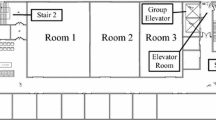Abstract
As the height and size of urban buildings constructed in cities in Korea have recently increased, vertical lift planning and operation is a key factor for the successful project of a tall building. Although many studies have attempted to set up a lift planning system at an early stage, a real-time lift operation control system with respect to the construction stage has yet to be proposed. Therefore, in this study, the sensor module and storage device named the Embedded Lift Information System (ELIS) was used to collect the lift operating data for improvement of lift operation efficiency in order to develop an optimum lift operating analysis system which could perform real-time analysis. Finally, the pattern of operation data of the lift was analyzed and the lift event of the next day was derived. In addition, we verified the efficiency of the proposed optimum vertical zoning simulation system using the expected lift event extracted from the operation history data pattern. In this paper, the proposed system provides more efficient vertical zoning alternatives for the lift manager. This simulation based decision making tool reduces the user’s queuing time compared with the previous system. This system is expected to contribute to high-rise building construction of over 400 m.
Similar content being viewed by others
References
Ahn, B. J. (2004). “A vertical movement plan for labors in high-rise building construction using discrete-event simulation.” Korean Journal of Construction Engineering and Management, KICEM, Vol. 5, No. 2, pp. 47–54.
Ahn, B. J. and Kim, J. J. (2001). “A decision-making model of integrated vertical and horizontal move plan for finishing material in righ-rise building construction.” Korean Journal of Construction Engineering and Management, KICEM, Vol. 2, No. 2, pp. 47–58.
Bolat, B., Altun, O., and Cortés, P. (2013). “A particle swarm optimization algorithm for optimal car-call allocation in elevator group control systems.” Applied Soft Computing, Vol. 13, No. 5, pp. 2633–2642, DOI: 10.1016/j.asoc.2012.11.023.
Cho, C. Y., Shin, Y. S., Won, S. K., Kim, J. Y., and Cho, M. Y. (2011). “An Algorithm for Hoisting Time Calculation in Super-tall Building Construction.” Korean Journal of Construction Engineering and Management, KICEM, Vol. 12, No. 6, pp. 120–129, DOI: 10.6106/KJCEM.2011.12.6.120.
Cortés, P., Larrañeta, J., and Onieva, L. (2004). “Genetic algorithm for controllers in elevator groups: Analysis and simulation during lunchpeak traffic.” Applied Soft Computing, Vol. 4, No. 2, pp. 159–174.
Huang, C, Wong, C. K., and Tam, C. M. (2010). “Optimization of material hoisting operations and storage locations in multi-storey building construction by mixed-integer programming.” Automation in Construction, Vol. 19, No. 5, pp. 656–663, DOI: 10.1016/j.autcon.2010.02.005.
Kim, D. J., Song, Y. S., and LIM, H. C. (2002). “Rationalization the lift car planning method in a high-rise building project.” Architectural Institute of Korea, Vol. 22, No. 2, pp. 483–486.
Kim, S. K. and Han, K. K. (2008). “A study on the estimation of proper numbers of construction lifts.” The Korea Institute of Building Construction, Vol. 8, No. 3, pp. 119–125, DOI: 10.5345/JKIC. 2008.8.3.119.
Lee, H. J., Kim, D. W., Cho, H. H., and Kang, K. I. (2008). “Development of the model using queueing theory for lifting planning in tall buildings.” Proceedings of the Korean Institute of Construction Engineering and Management, Vol. 8, pp. 635–640.
Lee, J. W. and Choi, J. P. (2010). “A study of algorithm in developing a program for elevator planning in high-rise buildings.” Proceeding of Annual Conference of the Architectural Institute of Korea, Vol. 30, No. 1, pp. 83–84.
Lee, Y. T., Kim, T. S., Cho, H. S., Sung, D. K., and Choi, B. D. (2008). “Performance analysis of an elevator system during up-peak”, Mathematical and Computer Modelling, Vol. 49, No. 3, pp. 423–431, DOI: 10.1016/j.mcm.2008.09.006.
Park, M. S., Ha, S. B., Lee, H. S., and Kim, S. Y. (2011). “An optimization model of temporary lift’s vertical zoning for worker lifting operation in the high-rise building construction.” Architectural Institute of Korea, Vol. 27, No. 11, pp. 193–202.
Park, M. S., Ha, S. B., Lee, H. S., Choi, Y. K., Kim, H. S., and Han, S. W. (2013). “Lifting demand-based zoning for minimizing worker vertical transportation time in high-rise building construction.” Automation in Construction, Vol. 32, pp. 88–95, DOI: 10.1016/j.autcon.2013.01.010.
Pepyne, L. (1997). “Optimal dispatching control for elevator systems during uppeak traffic.” IEEE Transactions on Control Systems Technology, Vol. 50, No. 6, pp. 629–643, DOI: 10.1109/87.641406.
Photios G. Ioannou, and Julio C. Martinez (1996). Scalable simulation models for construction operations, Proceedings of the 1996 Winter Simulation Conference.
Sacks, R., Navon, R., Brodetskaia, I., and Shapira, A. (2005). “Feasibility of Automated monitoring of lifting equipment in support of project control.” J. Constr. Eng. Manage, Vol. 131, No. 5, pp. 604–614, DOI: 10.1061/(ASCE)0733-9364(2005)131:5(604).
Shin, J. H. and Kwon, S. W. (2013). “Development of optimum construction lift operation system using sensing information for high-rise building.” Korea Journal of Construction Engineering and Management, Vol. 14, No. 5, pp. 153–163, DOI: 10.6106/KJCEM.2013.14.5.153.
Shin, S. Y. (2011). “Construction lift planning system in tall building construction.” Architectural Institute of Korea, Vol. 27, No. 11, pp. 227–235.
Yang, S., Tai, J., and Shao, C. (2009). “Dynamic partition of elevator group control system with destination floor guidance in up-peak traffic.” Journal of Computers, Vol. 4, No. 1, pp. 45–52, DOI: 10.4304/jcp.4.1.45-52.
Author information
Authors and Affiliations
Corresponding author
Rights and permissions
About this article
Cite this article
Shin, J., Kwon, S., Moon, D. et al. A Study on Method of Vertical Zoning of Construction Lift for High-rise Building based on Lift Planning & Operation History Database. KSCE J Civ Eng 22, 2664–2677 (2018). https://doi.org/10.1007/s12205-017-1374-3
Received:
Revised:
Accepted:
Published:
Issue Date:
DOI: https://doi.org/10.1007/s12205-017-1374-3




